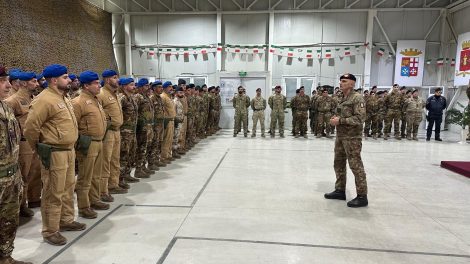What’s holding up deliveries? Italian Prime Minister Giorgia Meloni, along with Defence Minister Guido Crosetto, are fully committed to arming Ukraine’s resistance against the Russian invasion. As allied countries step up their contributions, Kyiv is urging Rome to keep up and increase supplies.
- Signalling a change of pace, France, Germany and the United States have begun to supply more offensive equipment, including tanks, to strengthen Ukraine’s counter-offensive efforts.
- Already-approved deliveries are ongoing insofar as Italy’s stockpile can guarantee them. However, Repubblica reported that the decision to greenlight a sixth weapons package might have been postponed until February – despite pressures from Washington and Kyiv.
- Citing sources in the executive, the daily reported that the government would decide at the end of January which and how many means to send to the Ukrainian resistance.
Coming up: PM Meloni hopes for a solution before February 24, when she plans to travel to Kyiv, so as to not arrive empty-handed. Mr Crosetto, in turn, boasts very close relations with the United States and will attend the January 20 Ukraine Defence Contact Group at the Ramstein Air Base in Germany, where NATO’s supplies to Ukraine are coordinated.
A matter of stock… During their last call, PM Meloni assured Ukrainian President Volodymyr Zelensky that her government was weighing deliveries of anti-missile and anti-drone equipment – including Skyguard-Aspide units (highly mobile, short-range surface-to-air missile system against airborne threats carried out at low and very low altitudes).
- The more advanced anti-air SAMP/T system is also being considered. Italy owns five, although one was sent to Kuwait, and another is yet to arrive from the US to replace a Patriot system in Slovakia (with the latter being provided to Ukraine).
- One SAMT/T system was rumoured to have been left in Turkey’s hands after it was deployed in Syria. That’s false: Decode39 can confirm it was handed back to Italy.
- The remaining three are undergoing cyclical maintenance, with one used for training. As the formers are needed to ensure the protection of Italian skies, the government seems inclined to provide the latter to Ukraine; however, French-supplied components (including the missiles themselves) are complicating that shipment.
… and (perhaps) politics. It’s no mystery that the PM’s biggest allies, Matteo Salvini and Silvio Berlusconi, have nurtured close relations with Vladimir Putin’s Russia in the past (and opposed sending weapons to Kyiv in the past months).
- Repubblica also reported that the two have been pressuring the PM to curb the stream of weapons. The government, however, has strenuously denied this hypothesis, noting that neither conditioning nor resistance has originated from their parties.
Kyiv’s urgency. Speaking to Repubblica, Mykhailo Podolyak – Adviser to the Head of the Office of President of Ukraine Volodymyr Zelensky – praised the relationship between the Italian and Ukrainian governments, noting PM Meloni “understands very well the nature of this war” and its repercussions on European security. Still, he warned that time is running out and urged Rome to speed up deliveries.
- “Any postponement [of weapons shipments] is very bad. Russia will not stop killing our people. Time plays in favour of the occupation army: it will bring additional reserves. And time freezes our chances. That is why we are waiting for quicker solutions.”
- The official highlighted that the anti-air assault equipment sought by Kyiv is necessary to protect civilians, critical infrastructure and large cities from cruise missiles and drones, whereas the offensive weapons are needed to support Ukraine’s counter-offensive and liberate the occupied territories.
- “We need MLRS systems and rockets with a range of 200 kilometres to destroy the Russian army’s backward infrastructure, ammunition and fuel storage. This will significantly reduce the combat capability of the Russians. We also need heavy tanks and armoured vehicles to advance quickly. And 155-millimetre barrel artillery and drones.”





